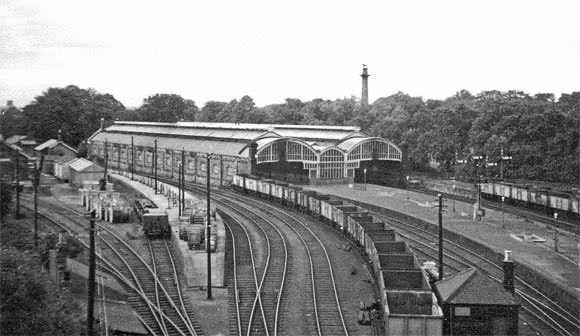
Alnwick
Alnwick Railway Station
Last Updated:
13 Feb 2025
Alnwick
This is a
Railway Station
55.409944, -1.699048
Founded in
Current status is
Extant
Designer (if known):
William Bell

Now in use by Barter Books
One of the highlights of Alnwick - a Victorian monument to the railway but internationally known today as a quaint second-hand bookshop.
A railway station has stood here since 1850 (contrary to other sources, which state for some reason it first opened in 1887). The first station stood directly to the south of the current one with a modest single platform and goods yard opposite the workhouse. Even before this however, the site was used as the terminus for the Shilbottle Waggonway which led south just north east of the aforementioned village. This pit had been sunk in 1807, so it was likely in use as a coal depot for a good couple decades before passenger use,
It originally only served the branch to Bilton Junction (later Alnmouth), but was expanded to its current scale in 1887 when the Cornhill Branch opened. The expansion allowed provision for proper waiting rooms, ticket offices, and refreshment rooms with extra platforms as an interchange for both lines. The Duke of Northumberland, an enduring advocate of the railways around Alnwick, provided his blessing. William Bell was also the architect, who designed many of the railway’s significant engineering marvels in the North including Darlington Station. Contemporary newspapers do state however that T E Harrison, the main who designed many of the North East's greatest viaducts, delivered plans for the project.
Such improvements paid dividends, and the station was incredibly busy for the next half century and kept the town on the map. However, the increase in car ownership was far more convenient given Alnwick’s placement on the main highway north and south. Folk still had to change services for an express to Scotland or London, or you’d be stuck on the stopper to Newcastle. Signs had already come to the furore in the 1900s, when excursions from the station were incredibly quiet with one excursion to Newcastle featuring 134 passengers and another only 2 dozen.
Passenger services closed in the first month of 1968, with goods ending some 10 months later. This came after a meeting with the Alnwick Rural and Urban Council and British Rail, stating the station was operating at an annual loss of £18k per annum, with income totalling £1800. There was little scope for a shuttle to Alnmouth due to the expense despite strong representation from the local area, especially as the 8:18am Alnwick to Newcastle train was still well used for work. Even Viscount Lambton, the MP for Berwick and the National Farmers Union campaigned for its retention. Goods traffic suspended in the September, with town making do with a public delivery siding at Alnmouth for general goods and Morpeth for livestock and parcels.
After a short period of disuse it has now become one of the most known bookshops in the country, and is a mecca for any keen indulger of books. The Aln Valley Railway Society was formed around the same time as Barter Books, with the ambition to bring a platform to the current Lidl site given much of the trackbed remained, though the plans were later quashed by the dualling of the A1 which would make an overbridge far too expensive.
Listing Description (if available)


Both Ordnance Survey maps shown depict the station in 1864 and the 1890s when it reached its zenith.
The first was surveyed in the early 1860s, a decade or so after opening. Though it featured an array of sidings, there was a single platform for passengers enclosed within the shed. The entrance was also further up Waggonway Road at this stage where the goods entrance would remain. This remained sufficient for workings to Alnmouth, though created a bottleneck once services to Cornhill commenced. We can see this change when we consider the 1890s map, with the two branches coming together just beyond Bridge Street. The old station building appeared to remain as a goods building but was superseded by the present complex featuring two platforms.

The Alnwick tithe award of 1846 provides a fascinating and rare insight before the Alnmouth to Alnwick branch. The Shilbottle waggonway can clearly be seen on the right of the map at the station site, with the coal depot allowing onwards transport of the mineral. The route of the waggonway is little known, though can be made out with some guesswork on the first Ordnance Survey map with the route now claimed by a country lane.

Alnwick Railway Station in February 2025

Alnwick Railway Station from a similar perspective round the 1950s. Unknown photographer, posted by the Aln Valley Railway, no copyright known.

The former entrance to the station, now for Barter Books, in February 2025
